Impact of Fires on Key Biodiversity Areas (KBAs) and Priority Bird Species for Conservation in Bolivia
Abstract
:1. Introduction
2. Materials and Methods
2.1. Study Area
2.2. Species Distribution
2.3. Impact of Wildfires
2.4. Wildfire Intensity
2.5. Statistical Analysis
3. Results
3.1. Biodiversity in the KBAs
3.2. Impact of Wildfires on the KBAs
3.3. Impact of Wildfires on Biodiversity
3.4. Impact of Wildfires on the Distribution of Priority Species
3.5. Wildfire Intensity
4. Discussion
5. Conclusions
Author Contributions
Funding
Data Availability Statement
Acknowledgments
Conflicts of Interest
Appendix A
| KBA Code | KBA Name | Area (ha) | Burnt Area 2001–2020 (ha) | Burnt Area 2001–2020 (%) | Frequency of Fires (% KBA) | ||||
|---|---|---|---|---|---|---|---|---|---|
| 1 | 2–4 | 5–7 | 8–10 | >10 | |||||
| 1 | Apolo | 193,503 | 13,501 | 7.0 | 89.6 | 10.4 | - | - | - |
| 2 | Área Natural de Manejo Integrado San Matías | 3,282,376 | 1,731,288 | 52.7 | 25.3 | 39.4 | 22.7 | 10.1 | 2.5 |
| 3 | Bajo Río Beni. Región Tacana | 485,525 | 161,984 | 33.4 | 31.5 | 30.5 | 25.7 | 11.3 | 1.0 |
| 4 | Bosque de Polylepis de Madidi | 103,456 | 3243 | 3.1 | 88.4 | 11.6 | - | - | - |
| 5 | Lagunas de Agua Dulce de Potosí | 346,301 | 0 | 0.0 | 100 | - | - | - | - |
| 6 | Lagunas Salinas de Potosí | 682,821 | 0 | 0.0 | 100 | - | - | - | - |
| 7 | Cuenca Cotacajes | 155,658 | 1561 | 1.0 | 100 | - | - | - | - |
| 8 | Cuencas de los Ríos Caine y Mizque | 373,471 | 150 | 0.0 | 100 | - | - | - | - |
| 9 | Bosque de Polylepis de Sanja Pampa | 2064 | 50 | 2.4 | 100 | - | - | - | - |
| 10 | Bosque de Polylepis de Mina Elba | 6350 | 325 | 5.1 | 74.4 | 25.6 | - | - | - |
| 11 | Bosque de Polylepis de Taquesi | 3799 | 225 | 5.9 | 88.7 | 11.3 | - | - | - |
| 12 | Yungas Inferiores de Carrasco | 466,993 | 9300 | 2.0 | 98.4 | 1.6 | - | - | - |
| 13 | Yungas Inferiores de Amboró | 329,261 | 4095 | 1.2 | 86.9 | 12.7 | 0.4 | - | - |
| 14 | Yungas Superiores de Mosetenes y Cocapata | 369,386 | 1334 | 0.4 | 87.2 | 12.8 | - | - | - |
| 15 | Yungas Superiores de Apolobamba | 474,724 | 18,843 | 4.0 | 92.3 | 7.7 | - | - | - |
| 16 | Yungas Superiores de Madidi | 262,217 | 7807 | 3.0 | 100 | - | - | - | - |
| 17 | Lago Poopó y Río Laka Jahuira | 264,652 | 1622 | 0.6 | 100 | - | - | - | - |
| 18 | Lago Titicaca (Sector Boliviano) | 421,641 | 75 | 0.0 | 29.2 | 29.2 | 28.1 | 12.0 | 1.5 |
| 19 | Parque Nacional Sajama | 107,975 | 100 | 0.1 | 39.3 | 60.7 | - | - | - |
| 20 | Noel Kempff Mercado | 2,247,479 | 459,975 | 20.5 | 40.1 | 39.8 | 12.6 | 5.3 | 2.2 |
| 21 | Reserva Biológica Cordillera de Sama | 104,929 | 10,977 | 10.5 | 97.5 | 2.5 | - | - | - |
| 22 | Cercanías de Riberalta | 49,747 | 10,266 | 20.6 | 27.9 | 48.5 | 14.9 | 5.4 | 3.2 |
| 23 | Vertiente Sur del Parque Nacional Tunari | 140,906 | 7094 | 5.0 | 100 | - | - | - | - |
| 24 | Alto Paraguá | 516,552 | 384,187 | 74.4 | 97.1 | 2.9 | - | - | - |
| 25 | Cristal Mayu y alrededores | 32,312 | 225 | 0.7 | 29.7 | 34.7 | 14.2 | 13.0 | 8.3 |
| 26 | Azurduy | 147,552 | 9326 | 6.3 | 100 | - | - | - | - |
| 27 | Cerrado de Riberalta | 55,099 | 17,080 | 31.0 | 100 | - | - | - | - |
| 28 | Cerro Q’ueñwa Sandora | 63,749 | 75 | 0.1 | 100 | - | - | - | - |
| 29 | Federico Román | 173,674 | 1629 | 0.9 | 100 | - | - | - | - |
| 30 | Yungas Inferiores de Madidi | 405,756 | 1200 | 0.3 | 97.6 | 2.4 | - | - | - |
| 31 | Yungas Inferiores de Isiboro-Sécure | 212,090 | 125 | 0.1 | 74.3 | 25.7 | - | - | - |
| 32 | Yungas Superiores de Amboró | 269,645 | 4150 | 1.5 | 100 | - | - | - | - |
| 33 | Yungas Superiores de Carrasco | 226,003 | 42,034 | 18.6 | 85.5 | 13.2 | 1.3 | - | - |
| 34 | Palmar de las Islas | 185,485 | 200 | 0.1 | 17.9 | 36.2 | 23.9 | 14.4 | 7.6 |
| 35 | Kaa-Iya del Gran Chaco | 3,231,642 | 1896 | 0.1 | 24.1 | 44.4 | 22.2 | 7.9 | 1.4 |
| 36 | Laguna Rogaguado y Ginebra | 341,746 | 183,818 | 53.8 | 64.3 | 33.0 | 2.7 | - | - |
| 37 | Loreto | 512,455 | 366,174 | 71.5 | 92.1 | 7.9 | - | - | - |
| 38 | Estación Biológica del Beni | 135,248 | 33,689 | 24.9 | 21.7 | 37.8 | 26.4 | 11.9 | 2.3 |
| 39 | Quebrada Mojón | 44,441 | 5670 | 12.8 | 72.8 | 27.2 | - | - | - |
| 40 | Reserva de Inmobilización de Iténez | 909,454 | 239,288 | 26.3 | 97.6 | 2.4 | - | - | - |
| 41 | Reserva Nacional Amazónica Manuripi | 766,353 | 20,858 | 2.7 | 88.1 | 11.9 | - | - | - |
| 42 | Reserva Nacional de Flora y Fauna Tariquia | 254,856 | 2930 | 1.1 | 73.9 | 23.7 | 2.4 | - | - |
| 43 | Tacacoma-Quiabaya y Valle Sorata | 95,877 | 2979 | 3.1 | 100 | - | - | - | - |
| 44 | Tahuamanu | 224,083 | 10,431 | 4.7 | 53.4 | 46.6 | - | - | - |
| 45 | Yungas Inferiores de Pilón Lajas | 272,561 | 425 | 0.2 | 100 | - | - | - | - |
| 46 | Serranía de Aguaragüe | 110,845 | 8784 | 7.9 | 42.7 | 12.2 | 4.9 | 17.3 | 23 |
| 47 | Serranía Bella Vista | 36,556 | 375 | 1.0 | 27.1 | 49.3 | 19.0 | 4.3 | 0.4 |
| 48 | Área Natural de Manejo Integrado Otuquis | 972,400 | 395,228 | 40.6 | 10.6 | 35.8 | 27.8 | 14.2 | 12 |
| 49 | Oeste del río Mamoré | 1,103,157 | 778,302 | 70.6 | 27.1 | 49.3 | 19.0 | 4.3 | - |
| 50 | Este del río Mamoré | 766,016 | 652,382 | 85.2 | 10.6 | 35.8 | 27.8 | 14.2 | 12 |
| 51 | Cotapata | 291,140 | 21,191 | 7.3 | 100 | - | - | - | - |
| 52 | Comarapa | 6473 | - | - | - | - | - | - | - |
| 53 | Río Huayllamarca | 5760 | - | - | - | - | - | - | - |
| 54 | Culpina | 6091 | - | - | - | - | - | - | - |
| 55 | Río Guadalquivir | 35,328 | - | - | - | - | - | - | - |
| 56 | Pampa Redonda | 11,174 | - | - | - | - | - | - | - |
| 57 | Prepuna del área del río San Juan | 18,073 | - | - | - | - | - | - | - |
| 58 | Cochabamba | 11,290 | - | - | - | - | - | - | - |
| Species | Endemic | UICN Category | Bolivia (ha) | KBA (ha) | Burnt Area/Bolivia (ha) | Burnt Area/KBA (ha) | Burnt Area/Bolivia (%) | Burnt Area/KBA (%) |
|---|---|---|---|---|---|---|---|---|
| Tinamus tao | VU | 25,259,872 | 5,916,650 | 2,799,725 | 308,325 | 11.1 | 5.2 | |
| Tinamus osgoodi | VU | 158,567 | 140,981 | 2875 | 2675 | 1.8 | 1.9 | |
| Nothoprocta taczanowskii | VU | 114,061 | 78,742 | 14,575 | 11,250 | 12.8 | 14.3 | |
| Crax globulosa | EN | 818,032 | 320,374 | 128,875 | 36,350 | 15.8 | 11.3 | |
| Crax fasciolata | VU | 25,001,932 | 5,659,089 | 7,980,425 | 1,454,725 | 31.9 | 25.7 | |
| Pauxi unicornis | X | CR | 974,109 | 743,220 | 10,325 | 4850 | 1.1 | 0.7 |
| Phoenicoparrus andinus | VU | 685,870 | 384,107 | 1975 | 1550 | 0.3 | 0.4 | |
| Rollandia microptera | EN | 597,987 | 537,810 | 1550 | 1500 | 0.3 | 0.3 | |
| Patagioenas subvinacea | VU | 31,754,317 | 5,809,445 | 5,474,875 | 457,292 | 17.2 | 7.9 | |
| Neomorphus geoffroyi | VU | 6,614,728 | 2,398,584 | 182,750 | 59,575 | 2.8 | 2.5 | |
| Eleothreptus candicans | VU | 219,799 | 232 | 129,225 | 0 | 58.8 | 0.0 | |
| Aglaeactis pamela | X | 976,049 | 218,893 | 67,875 | 36,000 | 7.0 | 16.4 | |
| Psophia viridis | VU | 26,619 | 16,740 | 275 | 200 | 1.0 | 1.2 | |
| Laterallus xenopterus | VU | 623,010 | 180,166 | 471,300 | 163,325 | 75.6 | 90.7 | |
| Agamia agami | VU | 18,050,717 | 4,494,573 | 2,020,150 | 346,350 | 11.2 | 7.7 | |
| Vultur gryphus | VU | 24,467,578 | 3,566,639 | 647,525 | 121,549 | 2.6 | 3.4 | |
| Spizaetus isidori | EN | 6,101,548 | 2,418,046 | 173,057 | 52,399 | 2.8 | 2.2 | |
| Buteogallus coronatus | EN | 27,146,927 | 7,649,742 | 10,591,525 | 2,790,425 | 39.0 | 36.5 | |
| Ramphastos culminatus | VU | 30,316,449 | 6,721,245 | 3,227,174 | 323,894 | 10.6 | 4.8 | |
| Capito dayi | VU | 2,707,614 | 1,553,855 | 322,225 | 116,975 | 11.9 | 7.5 | |
| Touit huetii | VU | 2,853,776 | 608,629 | 385,650 | 39,400 | 13.5 | 6.5 | |
| Myiopsitta luchsi | X | 2,403,318 | 363,260 | 3600 | 475 | 0.1 | 0.1 | |
| Amazona tucumana | VU | 2,315,790 | 216,696 | 94,414 | 8972 | 4.1 | 4.1 | |
| Pyrrhura perlata | VU | 3,940,722 | 1,750,782 | 621,375 | 119,750 | 15.8 | 6.8 | |
| Pyrrhura snethlageae | VU | 8,847,518 | 2,639,075 | 1,531,900 | 263,225 | 17.3 | 10.0 | |
| Anodorhynchus hyacinthinus | VU | 1,136,000 | 949,652 | 836,650 | 726,600 | 73.6 | 76.5 | |
| Primolius couloni | VU | 10,607,473 | 1,409,521 | 824,775 | 75,125 | 7.8 | 5.3 | |
| Ara glaucogularis | X | CR | 5,044,030 | 1,903,458 | 3,731,300 | 1,493,325 | 74.0 | 78.5 |
| Ara rubrogenys | X | CR | 2,581,914 | 392,616 | 10,675 | 3975 | 0.4 | 1.0 |
| Ara militaris | VU | 7,620,889 | 2,553,029 | 185,668 | 41,286 | 2.4 | 1.6 | |
| Euchrepomis sharpei | EN | 1,871,754 | 812,665 | 28,146 | 17,747 | 1.5 | 2.2 | |
| Hypocnemis ochrogyna | VU | 8,006,115 | 2,381,660 | 1,485,550 | 208,050 | 18.6 | 8.7 | |
| Hylopezus auricularis | X | VU | 49,808 | 25,050 | 5050 | 3175 | 10.1 | 12.7 |
| Geositta poeciloptera | VU | 323,179 | 320,467 | 209,825 | 208,775 | 64.9 | 65.1 | |
| Cinclodes aricomae | CR | 307,113 | 141,392 | 32,025 | 15,700 | 10.4 | 11.1 | |
| Asthenes berlepschi | X | 95,063 | 31,942 | 2675 | 1250 | 2.8 | 3.9 | |
| Asthenes harterti | X | 548,323 | 158,629 | 44,400 | 23,200 | 8.1 | 14.6 | |
| Asthenes helleri | VU | 146,117 | 107,656 | 18,575 | 14,850 | 12.7 | 13.8 | |
| Cranioleuca henricae | X | VU | 180,629 | 47,958 | 1725 | 700 | 1.0 | 1.5 |
| Cranioleuca curtata | VU | 2,692,172 | 1,163,412 | 23,021 | 10,102 | 0.9 | 0.9 | |
| Phibalura boliviana | X | EN | 420,463 | 228,057 | 18,650 | 14,700 | 4.4 | 6.4 |
| Lipaugus uropygialis | VU | 1,007,525 | 443,049 | 31,053 | 10,205 | 3.1 | 2.3 | |
| Cnipodectes superrufus | VU | 110,997 | 20,461 | 2,825 | 350 | 2.5 | 1.7 | |
| Zimmerius cinereicapilla | VU | 550,336 | 128,573 | 2300 | 200 | 0.4 | 0.2 | |
| Phyllomyias weedeni | VU | 1,245,022 | 432,825 | 6094 | 1232 | 0.5 | 0.3 | |
| Anairetes alpinus | EN | 295,573 | 195,260 | 31,580 | 24,832 | 10.7 | 12.7 | |
| Culicivora caudacuta | VU | 6,443,013 | 1,792,394 | 5,086,225 | 1,398,475 | 78.9 | 78.0 | |
| Alectrurus tricolor | VU | 4,531,974 | 1,335,363 | 3,760,300 | 1,128,375 | 83.0 | 84.5 | |
| Agriornis albicauda | VU | 7,009,968 | 338,221 | 49,734 | 20,117 | 0.7 | 5.9 | |
| Cinclus schulzii | VU | 451,414 | 46,929 | 23,425 | 4150 | 5.2 | 8.8 | |
| Turdus haplochrous | X | 4,489,831 | 302,390 | 1,800,100 | 131,000 | 40.1 | 43.3 | |
| Atlapetes rufinucha | X | 2,525,452 | 836,952 | 75,275 | 25,275 | 3.0 | 3.0 | |
| Oreopsar bolivianus | X | 3,128,908 | 443,207 | 7625 | 2825 | 0.2 | 0.6 | |
| Diglossa carbonaria | X | 1,580,198 | 270,379 | 62,525 | 35,825 | 4.0 | 13.2 | |
| Sporophila nigrorufa | VU | 525,873 | 336,433 | 319,975 | 196,625 | 60.8 | 58.4 | |
| Sporophila maximiliani | EN | 9,974,039 | 2,583,537 | 6,923,925 | 2,004,725 | 69.4 | 77.6 | |
| Coryphaspiza melanotis | VU | 4,663,450 | 1,103,558 | 3,828,675 | 921,700 | 82.1 | 83.5 | |
| Poospiza garleppi | X | EN | 647,396 | 100,099 | 18,500 | 7150 | 2.9 | 7.1 |
| Poospiza baeri | VU | 78,810 | 14,824 | 2925 | 1675 | 3.7 | 11.3 | |
| Stilpnia argyrofenges | VU | 2,987,003 | 1,546,496 | 71,652 | 30,056 | 2.4 | 1.9 |
References
- Jolly, W.M.; Cochrane, M.A.; Freeborn, P.H.; Holden, Z.A.; Brown, T.J.; Williamson, G.J.; Bowman, D.M. Climate-induced variations in global wildfire danger from 1979 to 2013. Nat. Commun. 2015, 6, 7537. [Google Scholar] [CrossRef]
- Pausas, J.G.; Keeley, J.E. Wildfires and global change. Front. Ecol. Environ. 2021, 19, 387–395. [Google Scholar] [CrossRef]
- Giglio, L.; Boschetti, L.; Roy, D.P.; Humber, M.L.; Justice, C.O. The Collection 6 MODIS burned area mapping algorithm and product. Remote Sens. Environ. 2018, 217, 72–85. [Google Scholar] [CrossRef]
- Lizundia-Loiola, J.; Pettinari, M.L.; Chuvieco, E. Temporal Anomalies in Burned Area Trends: Satellite Estimations of the Amazonian 2019 Fire Crisis. Remote Sens. 2020, 12, 151. [Google Scholar] [CrossRef] [Green Version]
- McLauchlan, K.K.; Higuera, P.E.; Miesel, J.; Rogers, B.M.; Schweitzer, J.; Shuman, J.K.; Tepley, A.J.; Varner, J.M.; Veblen, T.T.; Adalsteinsson, S.A.; et al. Fire as a fundamental ecological process: Research advances and frontiers. J. Ecol. 2020, 108, 2047–2069. [Google Scholar] [CrossRef]
- Tingley, M.W.; Ruiz-Gutiérrez, V.; Wilkerson, R.L.; Howell, C.A.; Siegel, R.B. Pyrodiversity promotes avian diversity over the decade following forest fire. Proc. R. Soc. B Biol. Sci. 2016, 283, 20161703. [Google Scholar] [CrossRef] [Green Version]
- Olsen, P.; Weston, M. Fire and Birds: Fire Management for Biodiversity; Supplement to Wingspan; Birds Australia: Victoria, Australia, 2005; Volume 15. [Google Scholar]
- Kelly, L.T.; Giljohann, K.M.; Duane, A.; Aquilué, N.; Archibald, S.; Batllori, E.; Bennett, A.F.; Buckland, S.T.; Canelles, Q.; Clarke, M.F.; et al. Fire and biodiversity in the Anthropocene. Science 2020, 370, eabb0355. [Google Scholar] [CrossRef]
- Kelly, L.T.; Brotons, L. Using fire to promote biodiversity. Science 2017, 355, 1264–1265. [Google Scholar] [CrossRef]
- Pivello, V.R. Fire Management for Biological Conservation in the Brazilian Cerrado. In Savana and Dry Forests Linking People with Nature; Mistry, J., Berardi, A., Eds.; Ashgate Publishing: Farnham, UK, 2006; pp. 129–154. [Google Scholar]
- Wood, J.R.I.; Mamani, F.; Pozo, P.; Soto, D.; Villarroel, D. Libro Rojo de las Plantas de los Cerrados del Oriente Boliviano; Darwin Iniative & Museo de Historia Natural Noel Kempff Mercado: Santa Cruz de la Sierra, Bolivia, 2010; 153p. [Google Scholar]
- Myers, R.L. Living with Fire—Sustaining Ecosystems & Livelihoods through Integrated Fire Management; Global Fire Initiative; The Nature Conservancy: Tallahassee, FL, USA, 2006; 36p. [Google Scholar]
- Maillard, O.; Anívarro, R.; Vides-Almonacid, R.; Torres, W. Estado de conservación de los ecosistemas de las serranías chiquitanas: Un caso de estudio de la Lista Roja de Ecosistemas de la UICN en Bolivia. Ecología En Bolivia 2018, 53, 128–149. [Google Scholar]
- Pinto, C.; Vroomans, V. Chaqueos e Incendios Forestales en Bolivia; Instituto Boliviano de Investigación Forestal: Santa Cruz de la Sierra, Bolivia, 2007. [Google Scholar]
- Bilbao, B.; Steil, L.; Urbieta, I.R.; Anderson, L.; Pinto, C.; González, M.E.; Millán, A.; Falleiro, R.M.; Morici, E.; Ibarnegaray, V.; et al. Wildfires. In Adaptation to Climate Change Risks in Ibero-American Countries; Moreno, J.M., Laguna-Defior, C., Barros, V., Calvo Buendía, E., Marengo, J.A., Oswald Spring, U., Eds.; RIOCCADAPT Report; McGraw Hill: New York, NY, USA, 2020; pp. 435–496. [Google Scholar]
- Villegas, Z.; Mostacedo, B. Diagnóstico de la Situación Actual Sobre Políticas, Información, Avances y Necesidades Futuras Sobre MRV en Bolivia; CIFOR: Bogor, Indonesia, 2011; 64p. [Google Scholar]
- FAN (Fundación Amigos de la Naturaleza). Atlas Socioambiental de las Tierras Bajas y Yungas de Bolivia. Segundaª Edición; Editorial FAN: Santa Cruz de la Sierra, Bolivia, 2016. [Google Scholar]
- Devisscher, T.; Boyd, E.; Malhibb, Y. Anticipating future risk in social-ecological systems using fuzzy cognitive mapping: The case of wildfire in the Chiquitania, Bolivia. Ecol. Soc. 2016, 21, 18. [Google Scholar] [CrossRef] [Green Version]
- Rodríguez, A. Cartografía multitemporal de quemas e incendios forestales en Bolivia: Detección y validación post-incendio. Ecología En Bolivia 2012, 47, 53–71. [Google Scholar]
- TIERRA. Fuego en Santa Cruz. Balance de los Incendios Forestales 2019 y su Relación con La Tenencia de la Tierra; Edición TIERRA: Santa Cruz de la Sierra, Bolivia, 2019. [Google Scholar]
- Romero-Muñoz, A.; Jansen, M.; Nuñez, A.M.; Toledo, M.; Almonacid, R.V.; Kuemmerle, T. Fires scorching Bolivia’s Chiquitano forest. Science 2019, 366, 1082. [Google Scholar] [CrossRef]
- Maillard, O.; Vides-Almonacid, R.; Flores-Valencia, M.; Coronado, R.; Vogt, P.; Vicente-Serrano, S.M.; Azurduy, H.; Anívarro, R.; Cuellar, R.L. Relationship of Forest Cover Fragmentation and Drought with the Occurrence of Forest Fires in the Department of Santa Cruz, Bolivia. Forests 2020, 11, 910. [Google Scholar] [CrossRef]
- Anívarro, R.; Azurduy, H.; Maillard, O.; Markos, A. Diagnóstico por Teledetección de Áreas Quemadas en la Chiquitania; Informe técnico del Observatorio Bosque Seco Chiquitano, Fundación para la Conservación del Bosque Chiquitano: Santa Cruz de la Sierra, Bolivia, 2019; 70p. [Google Scholar]
- WCS. Valores de Conservación en Riesgo por la Ocurrencia de Focos de Calor. Boletín 2 Periodo de Análisis Julio-Agosto 2020; WCS: La Paz, Bolivia, 2020. [Google Scholar]
- FAN & WCS. Incendios Forestales en Bolivia-Análisis de Impactos de Los Incendios Forestales Sobre Los Valores de Conservación en Bolivia, 2020; Fundación Amigos de la Naturaleza: Santa Cruz de la Sierra, Bolivia, 2021. [Google Scholar]
- Pacheco, L.F.; Quispe-Calle, L.C.; Suárez-Guzmán, F.A.; Ocampo, M.; Claure-Herrera, Á.J. Muerte de mamíferos por los incendios de 2019 en la Chiquitania. Ecología En Bolivia 2021, 56, 4–16. [Google Scholar]
- Maillard, O.; Angulo, S.; Vides-Almonacid, R.; Rumiz, D.; Vogt, P.; Monroy-Vilchis, O.; Justiniano, H.; Azurduy, H.; Coronado, R.; Venegas, C.; et al. Integridad del paisaje y riesgos de degradación del hábitat del jaguar (Panthera onca) en áreas ganaderas de las tierras bajas de Santa Cruz, Bolivia. Ecología En Bolivia 2020, 55, 94–110. [Google Scholar]
- KBA (KBA Standards and Appeals Committee). Guidelines for Using a Global Standard for the Identification of Key Biodiversity Areas; Version 1.1; Prepared by the KBA Standards and Appeals Committee of the IUCN Species Survival Commission and IUCN World Commission on Protected Areas; IUCN KBA Standards and Appeals Committee: Gland, Switzerland, 2020; 206p. [Google Scholar]
- Soria Auza, R.W.; Hennessey, A.B. Áreas Importantes para la Conservación de las Aves en Bolivia and Áreas Importantes para la Conservación de las Aves en las Andes Tropicales: Sitios prioritarios para la conservación de la biodiversidad. In BirdLife International and Conservation International; BirdLife Conservation Series No. 14; BirdLife International: Quito, Ecuador, 2005; pp. 57–116. [Google Scholar]
- Maillard, Z.; Hennessey, A.B.; Davis, S.E. Bolivia. In Important Bird Areas of the Americas; Devenish, C., Diaz Fernandez, D.F., Clay, R.P., Davidson, I.J., Eds.; BirdLife Conservation Series 16; BirdLife International: Quito, Ecuador, 2010; pp. 91–98. [Google Scholar]
- Ibisch, P.L.; Beck, S.G.; Gerkmann, B.; Carretero, A. Ecorregiones y ecosistemas. In Biodiversidad: La Riqueza de Bolivia. Estado de Conocimiento Y Conservación. Ministerio de Desarrollo Sostenible; Ibisch, P.L., Mérida, G., Eds.; Editorial FAN: Santa Cruz de la Sierra, Bolivia, 2003; pp. 47–88. [Google Scholar]
- BirdLife International. Important Bird and Biodiversity Areas: A Global Network for Conserving Nature and Benefiting People; BirdLife International: Cambridge, UK, 2014. [Google Scholar]
- Herzog, S.K.; Terrill, R.S.; Jahn, A.; Remsen, J.V., Jr.; Maillard, O.; García-Soliz, V.H.; MacLeod, R.; Maccormick, A.; Vidoz, J.Q. Birds of Bolivia—Field Guide; Asociación Armonía, Santa Cruz de la Sierra, Bolivia and Future Generations University: Franklin, TN, USA, 2019; 491p. [Google Scholar]
- MAAyA (Ministerio de Medio Ambiente y Agua). Libro Rojo de la Fauna Silvestre de Vertebrados de Bolivia; Ministerio de Medio Ambiente y Agua: La Paz, Bolivia, 2009. [Google Scholar]
- Herzog, S.; Maillard, O.; Embert, D.; Caballero, P.; Quiroga, D. Range size estimates of Bolivian endemic bird species revisited: The importance of environmental data and national expert knowledge. J. Ornithol. 2012, 153, 1189–1202. [Google Scholar] [CrossRef]
- Navarro, G.; Ferreira, W. Mapa de Vegetación de Bolivia, Esc.1:250,000. Edición Digital; The Nature Conservancy: Santa Cruz de la Sierra, Bolivia, 2007. [Google Scholar]
- Züchner, T.; Boesman, P.F.D.; Sharpe, C.J. Coppery Thorntail (Discosura letitiae), version 1.0. In Birds of the World; del Hoyo, J., Elliott, A., Sargatal, J., Christie, D.A., de Juana, E., Eds.; Cornell Lab of Ornithology: Ithaca, NY, USA, 2020. [Google Scholar]
- Gorelick, N.; Hancher, M.; Dixon, M.; Ilyushchenko, S.; Thau, D.; Moore, R. Google Earth Engine: Planetary-scale geospatial analysis for everyone. Remote Sens. Environ. 2017, 202, 18–27. [Google Scholar] [CrossRef]
- Kaufman, Y.J.; Justice, C.O.; Flynn, L.P.; Kendall, J.D.; Prins, E.M.; Giglio, L.; Ward, D.E.; Menzel, W.P.; Setzer, A.W. Potential global fire monitoring from EOS-MODIS. J. Geophys. Res. 1998, 103, 32215–32238. [Google Scholar] [CrossRef]
- Wooster, M.J.; Roberts, G.; Perry, G.L.W.; Kaufman, Y.J. Retrieval of biomass combustion rates and totals from fire radiative power observations: FRP derivation and calibration relationships between biomass consumption and fire radiative energy release. J. Geophys. Res. 2005, 110, D24311. [Google Scholar] [CrossRef]
- Ichoku, C.; Giglio, L.; Wooster, M.J.; Remer, L.A. Global characterization of biomass-burning patterns using satellite measurements of fire radiative energy. Remote Sens. Environ. 2008, 112, 2950–2962. [Google Scholar] [CrossRef]
- Herzog, S.K.; Soria Auza, R.W.; Bennett Hennessey, A. Patrones ecorregionales de riqueza, endemismo y amenaza de la avifauna boliviana: Prioridades para la planificación ecorregional. Ecología En Bolivia 2005, 40, 27–40. [Google Scholar]
- Maillard, O.; Anivarro, R.; Vides-Almonacid, R.; Salinas, J.C. El impacto de la infraestructura vial en ecosistemas de alta fragilidad: El caso de la construcción de una carretera en el norte chiquitano, Bolivia. In Bolivia. Desafíos Socioambientales en Las Tierras Bajas; Inturias, M., Von Stosch, K., Balderlomar, H., Rodriguez, I., Eds.; Instituto de Investigación Científica Social (IICS) de la Universidad Nur: Santa Cruz de la Sierra, Bolivia, 2019; pp. 119–149. [Google Scholar]
- Asociación Armonía. Estado de Conservación de Las Aves en Bolivia; Asociación Armonía: Santa Cruz de la Sierra, Bolivia, 2012; 28p. [Google Scholar]
- Yépez, I.; Devenish, C.; Clay, R.P. Important Bird Areas in the Amazon Basin; BirdLife International: Quito, Ecuador, 2009. [Google Scholar]
- McDaniel, J.; Kennard, D.; Fuentes, A. Smokey the tapir: Traditional fire knowledge and fire prevention campaigns in lowland Bolivia. Soc. Nat. Resour. 2005, 18, 921–931. [Google Scholar] [CrossRef]
- Devisscher, T.; Anderson, L.O.; Aragão, L.E.O.C.; Galván, L.; Malhi, L. Increased wildfire risk driven by climate and development interactions in Bolivian Chiquitania, southern Amazonia. PLoS ONE 2016, 11, e0161323. [Google Scholar] [CrossRef] [PubMed] [Green Version]
- He, T.; Lamont, B.B.; Pausas, J.G. Fire as a key driver of Earth’s biodiversity. Biol. Rev. Camb. Philos. Soc. 2019, 94, 1983–2010. [Google Scholar] [CrossRef]
- Nasi, R.; Dennis, R.; Meijaard, E.; Applegate, G.; Moore, P. Forest fire and biological diversity. Unasylva 2002, 209, 36–40. [Google Scholar]
- Pastro, L.A.; Dickman, C.R.; Letnic, M. Burning for biodiversity or burning biodiversity? Prescribed burn vs. wildfire impacts on plants, lizards, and mammals. Ecological Applications 2011, 21, 3238–3253. [Google Scholar] [CrossRef]
- Bond, W.J.; Keane, R.E. Fires, Ecological Effects of. Reference Module in Life Sciences; Elsevier: Amsterdam, The Netherlands, 2017. [Google Scholar] [CrossRef]
- Cochrane, M.A. Spreading Like Wildfire—Tropical Forest Fires in Latin America and the Caribbean: Prevention, Assessment and Early Warning; United Nations Environment Programme (UNEP): Mexico City, Mexico, 2002. [Google Scholar]
- Sodhi, N.S.; Sekercioglu, C.H.; Barlow, J.; Robinson, S.K. Fire and the Conservation of Tropical Birds. In Conservation of Tropical Birds; Sodhi, N.S., Sekercioglu, C.H., Barlow, J., Robinson, S.K., Eds.; Wiley-Blackwell: Cambridge, UK, 2011; pp. 109–125. [Google Scholar]
- Barlow, J.; Haugaasen, T.; Peres, C. Effects of ground fires on understorey bird assemblages in Amazonian forests. Biol. Conserv. 2002, 105, 157–169. [Google Scholar] [CrossRef]
- Mestre, L.A.; Cochrane, M.A.; Barlow, J. Long-term Changes in Bird Communities after Wildfires in the Central Brazilian Amazon. Biotropica 2013, 45, 480–488. [Google Scholar] [CrossRef]
- Fredericksen, N.J.; Fredericksen, T.S. Terrestrial wildlife responses to logging and fire in a Bolivian tropical humid forest. Biodiv. Conserv. 2002, 11, 27–38. [Google Scholar] [CrossRef]
- Mostacedo, B.; Fredericksen, T.; Gould, K.; Toledo, M. Comparación de la Respuesta de las Comunidades Vegetales a los Incendios Forestales en los Bosques Tropicales Secos Y Húmedos de Bolivia; Documento Técnico 83/1999; Proyecto de Manejo Forestal Sostenible BOLFOR: Santa Cruz, Bolivia, 1999. [Google Scholar]
- Fredericksen, T.S.; Justiniano, M.J.; Mostacedo, B.; Kennard, D.; McDonald, L. Comparative regeneration ecology of three leguminous timber species in a Bolivian tropical dry forest. New For. 2000, 20, 45–64. [Google Scholar] [CrossRef]
- Gould, K.A.; Fredericksen, T.S.; Morales, F.; Kennard, D.; Putz, F.E.; Mostacedo, B.; Toldeo, M. Post-fire tree regeneration in lowland Bolivia: Implications for fire management. For. Ecol. Manag. 2002, 185, 225–234. [Google Scholar] [CrossRef]
- Kennard, D.K.; Gould, K.; Putz, F.E.; Fredericksen, T.S.; Morales, F. Effect of disturbance intensity on regeneration mechanisms in a tropical dry forest. For. Ecol. Manag. 2002, 162, 197–208. [Google Scholar] [CrossRef] [Green Version]
- Veldman, J.W.; Mostacedo, B.; Peña-Claros, M.; Putz, F.E. Selective logging and fire as drivers of alien grass invasion in a Bolivian tropical dry forest. For. Ecol. Manag. 2009, 258, 1643–1649. [Google Scholar] [CrossRef]
- Bates, J.M.; Parker, T.A., III; Capparella, A.P.; Davis, T.J. Observations on the campo, cerrado and forest avifaunas of eastern Dpto. Santa Cruz, Bolivia, incluiding 21 species newto the country. Bull. Br. Ornithol. Club 1992, 112, 86–98. [Google Scholar]
- Machado, T.L.; Lombardi, V.T.; de Meireles, R.C.; Teixeira, J.P.; Solar, R.R.; Lopes, L.E. Breeding biology of the threatened Campo Miner Geositta poeciloptera (Aves: Scleruridae), a Neotropical grassland specialist. J. Nat. Hist. 2017, 51, 2551–2563. [Google Scholar] [CrossRef]
- Hordijk, I.; Meijer, F.; Nissen, E.; Boorsma, T.; Poorter, L. Cattle affect regeneration of the palm species Attalea princeps in a Bolivian forest–savanna mosaic. Biotropica 2019, 51, 28–38. [Google Scholar] [CrossRef] [Green Version]
- Jones, J.P.; Asner, G.P.; Butchart, S.H.; Karanth, K.U. The ‘why’, ‘what’ and ‘how’ of monitoring for conservation. In Key Topics in Conservation Biology; MacDonald, D.W., Willis, K.J., Eds.; Wiley-Blackwell: Cambridge, UK, 2013; pp. 327–343. [Google Scholar]
- Crowley, M.A.; Cardille, J.A. Remote Sensing’s Recent and Future Contributions to Landscape Ecology. Curr. Landsc. Ecol. Rep. 2020, 5, 45–57. [Google Scholar] [CrossRef]
- Pettinari, M.L.; Chuvieco, E. Fire Danger Observed from Space. Surv. Geophys. 2020, 41, 1437–1459. [Google Scholar] [CrossRef]
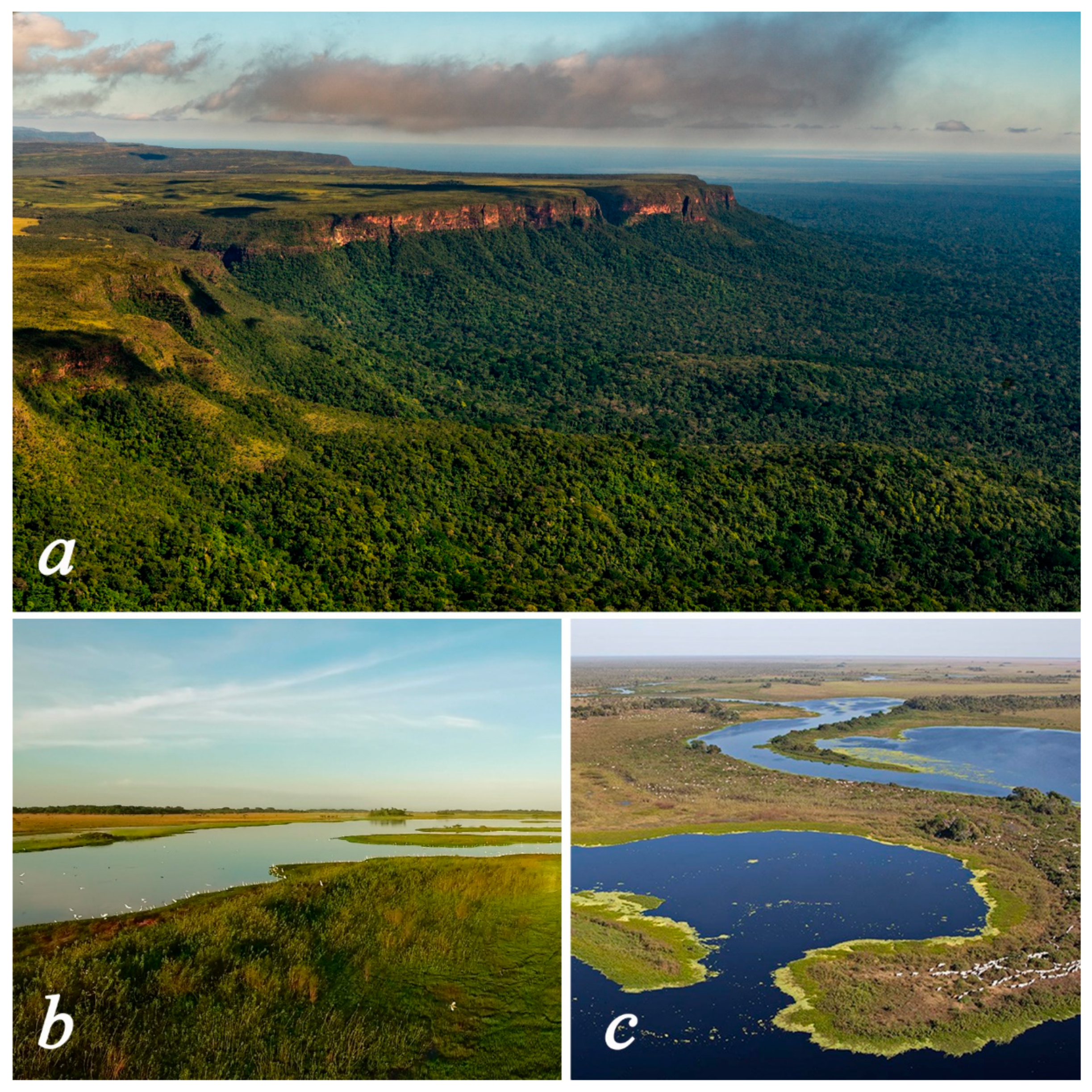
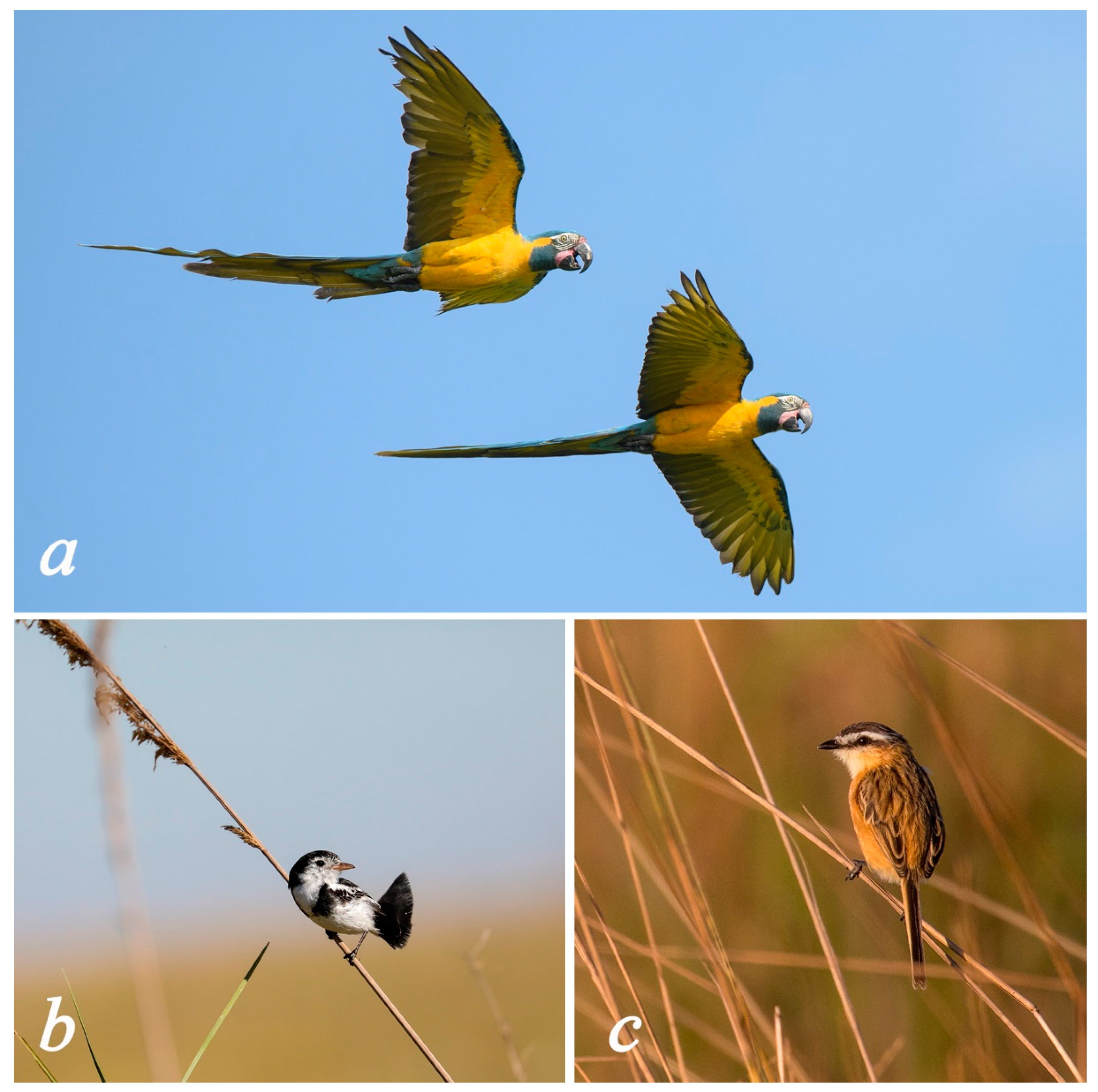
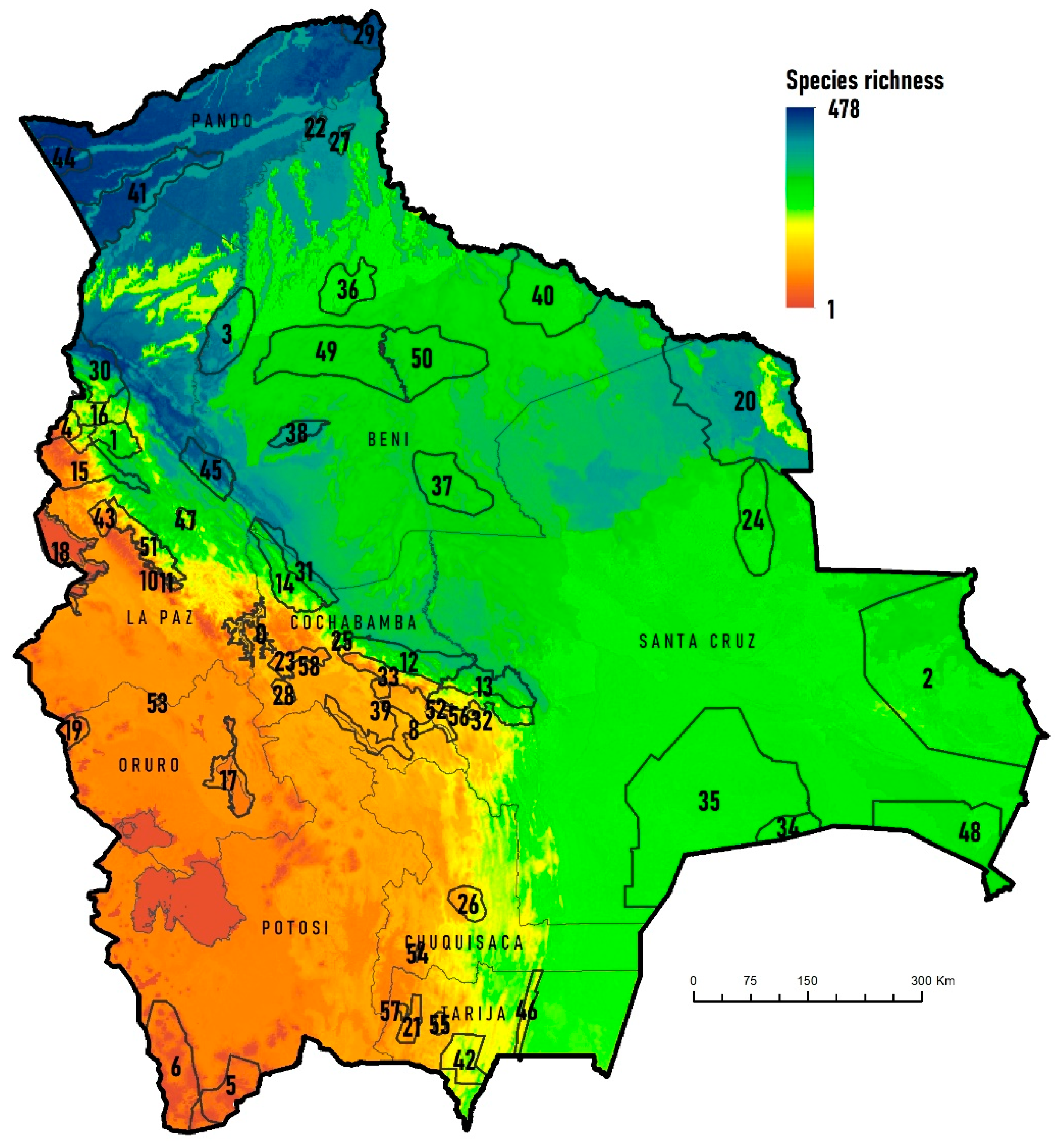
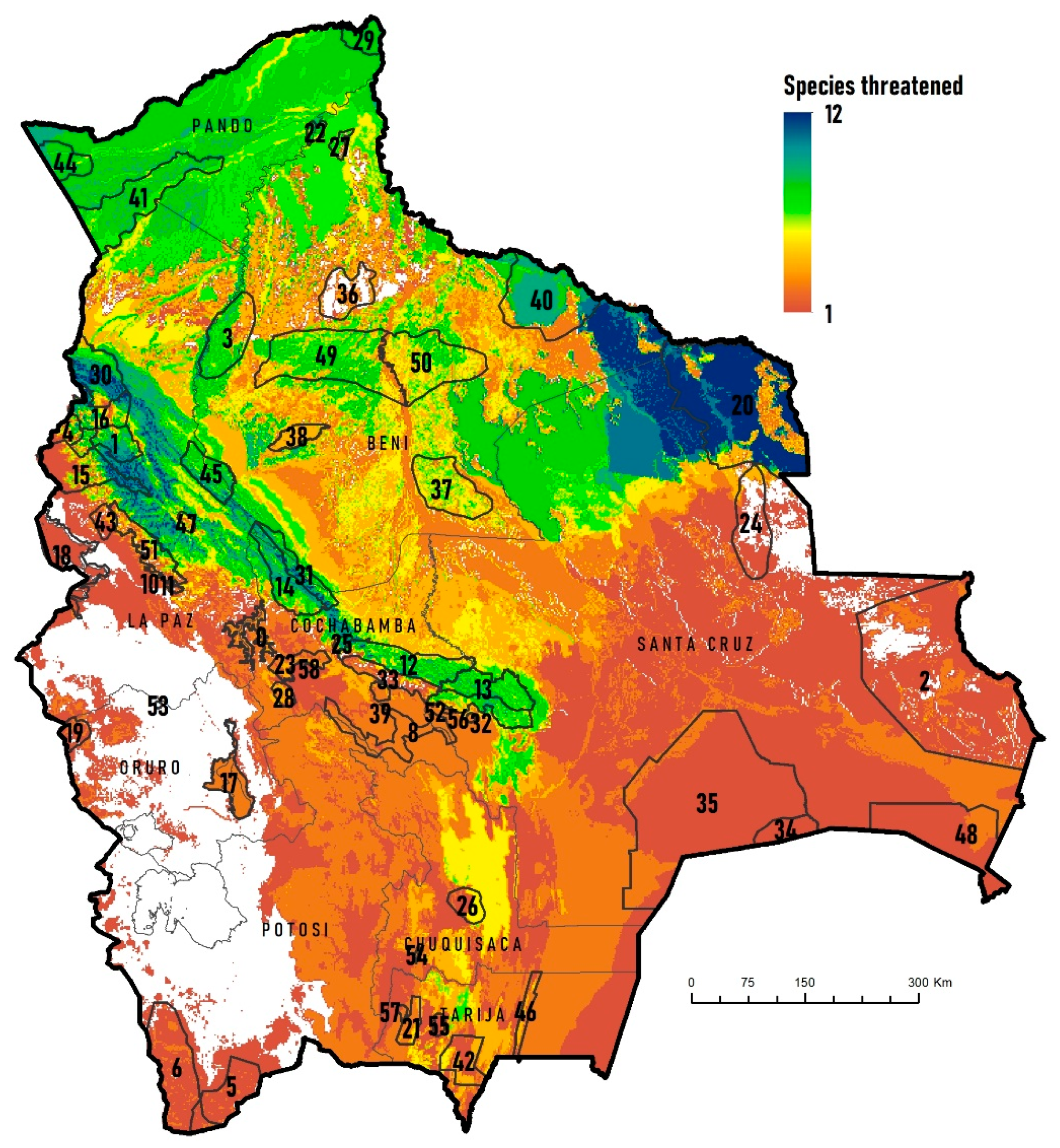
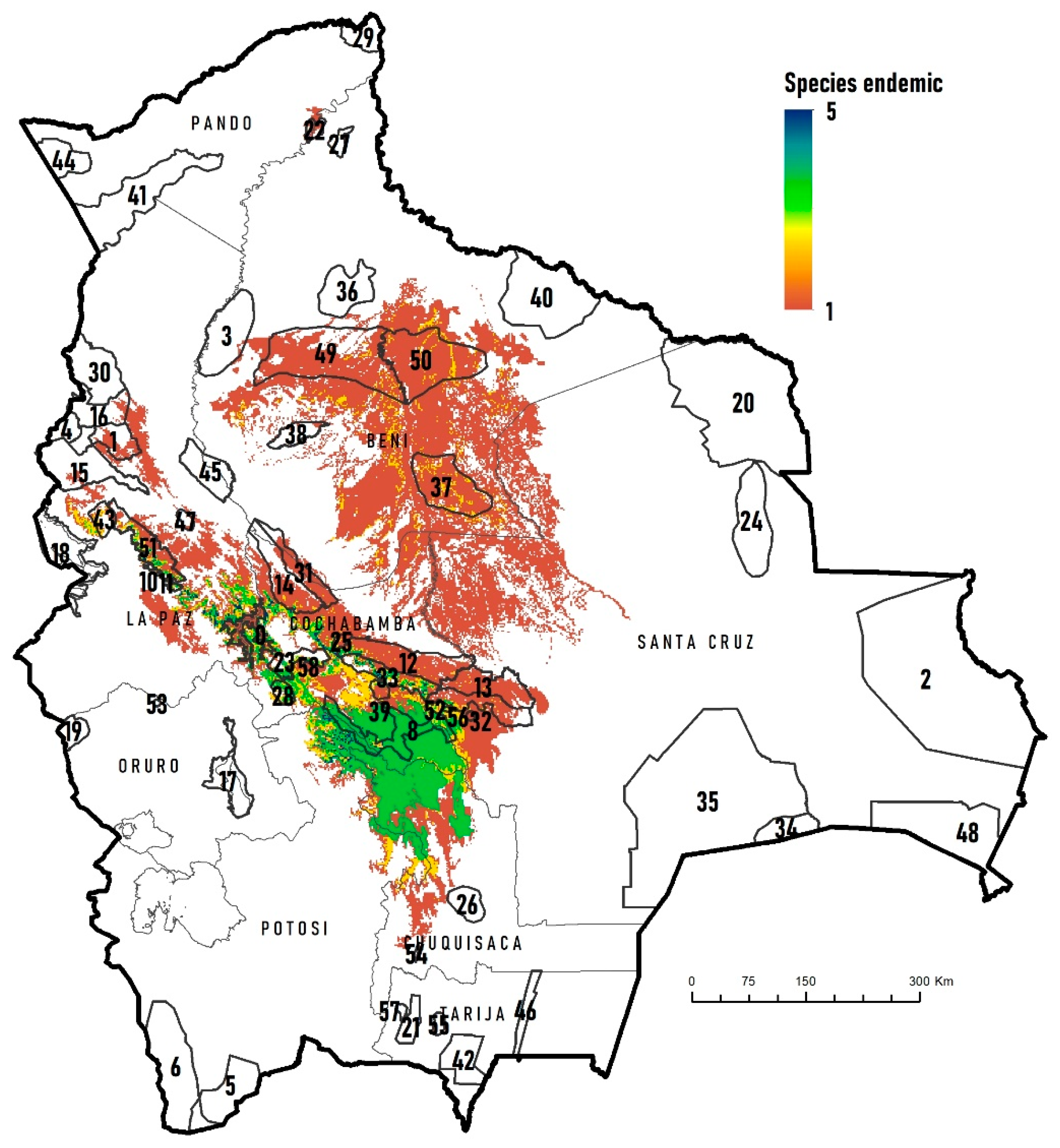
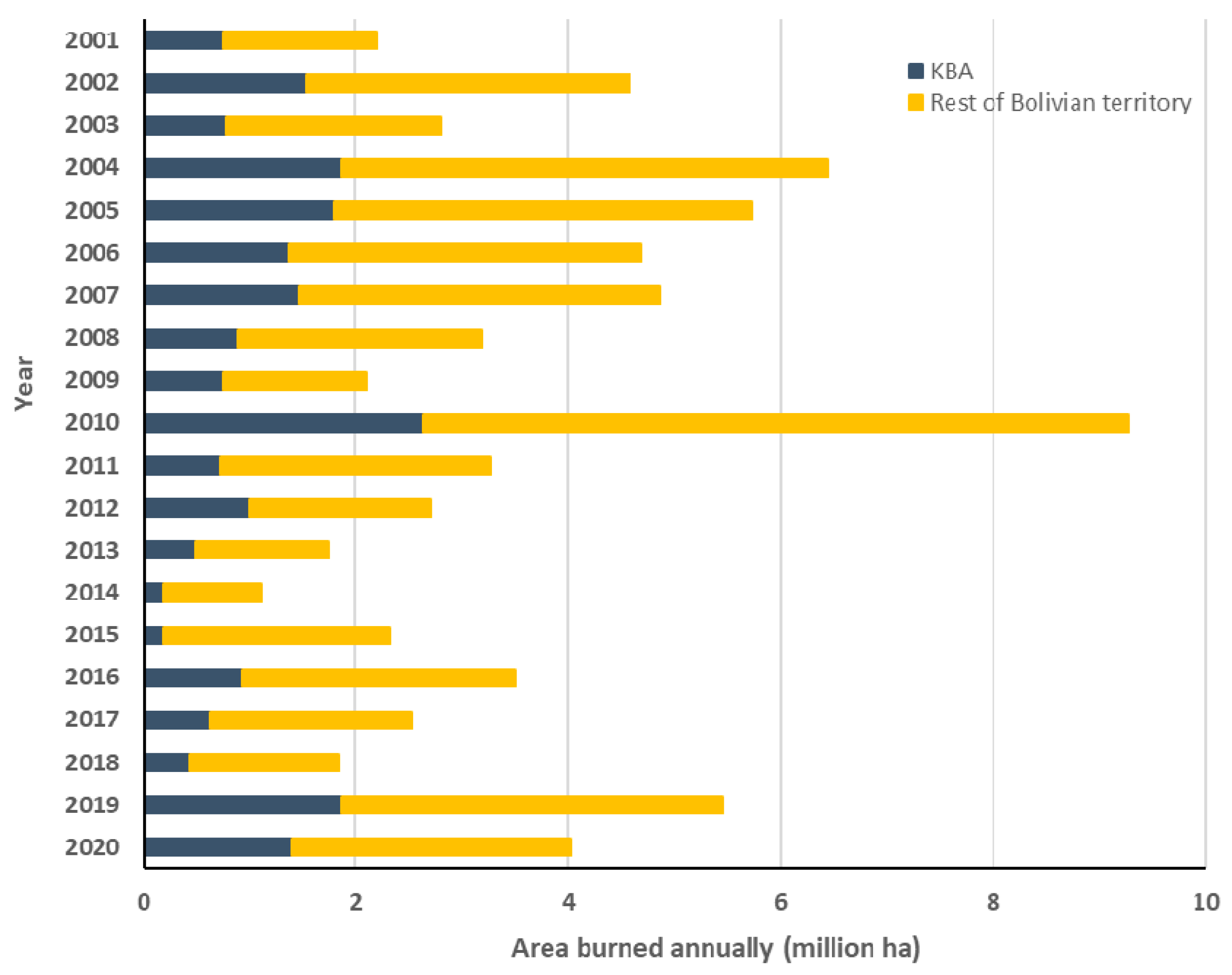
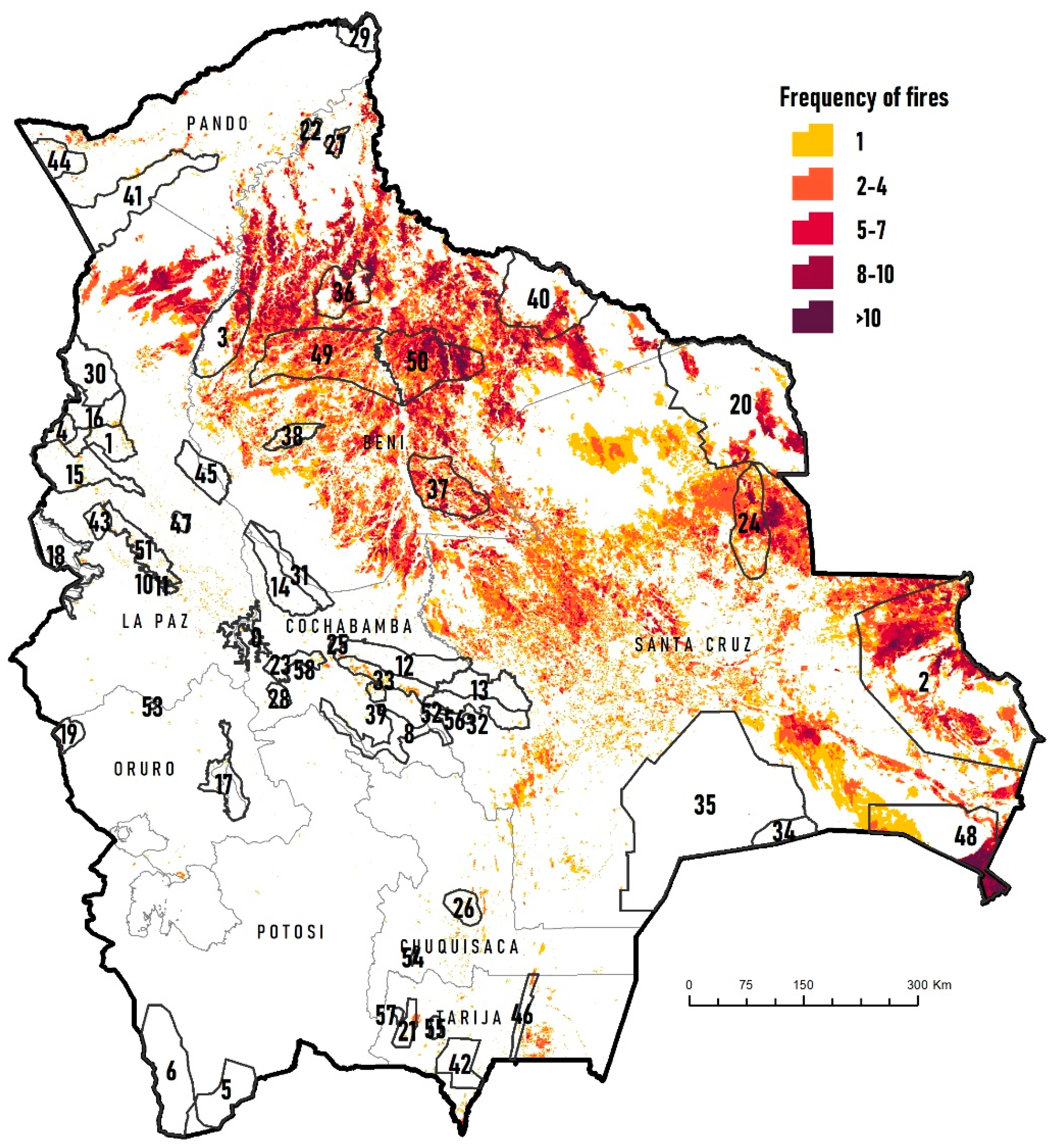
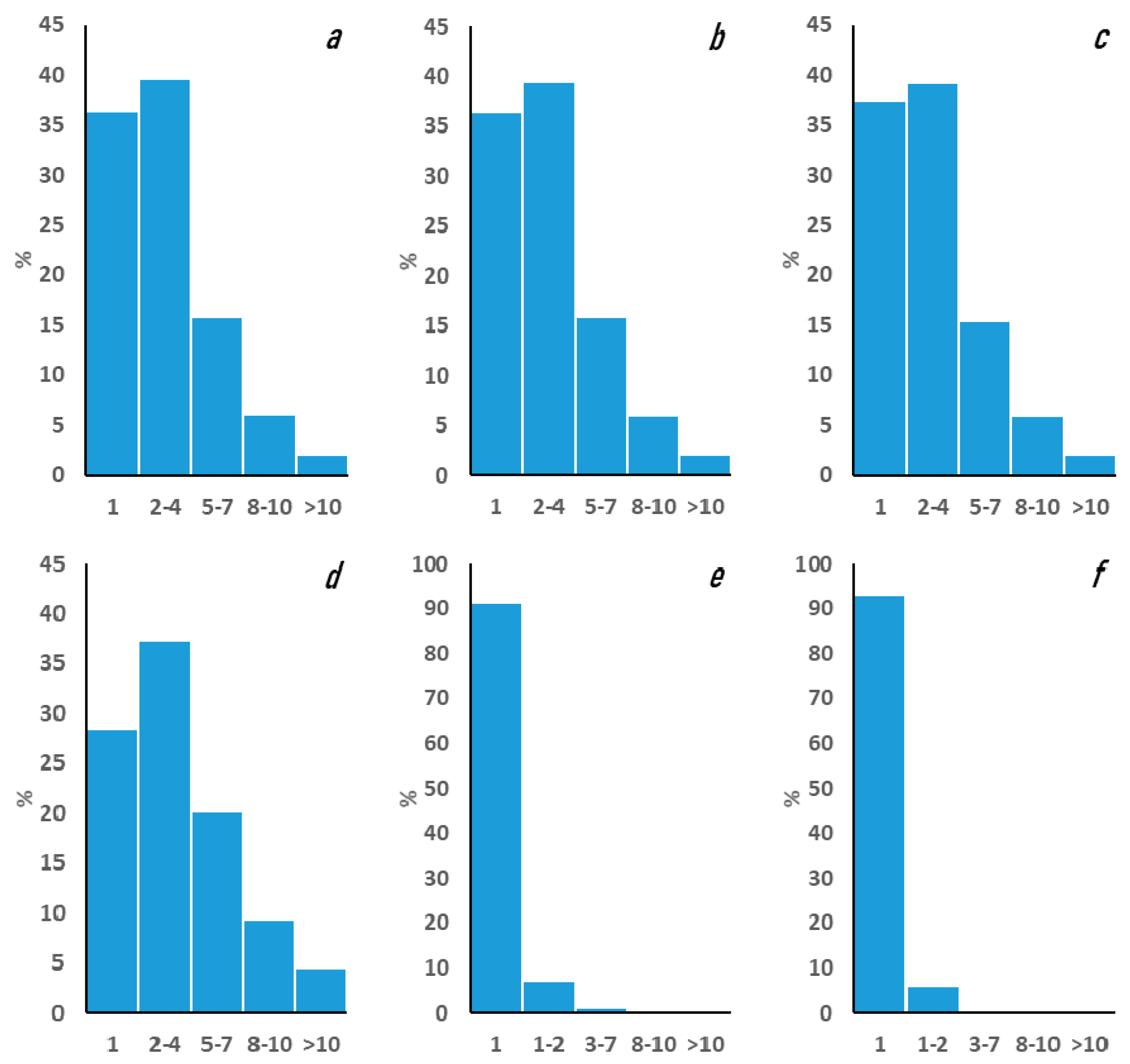
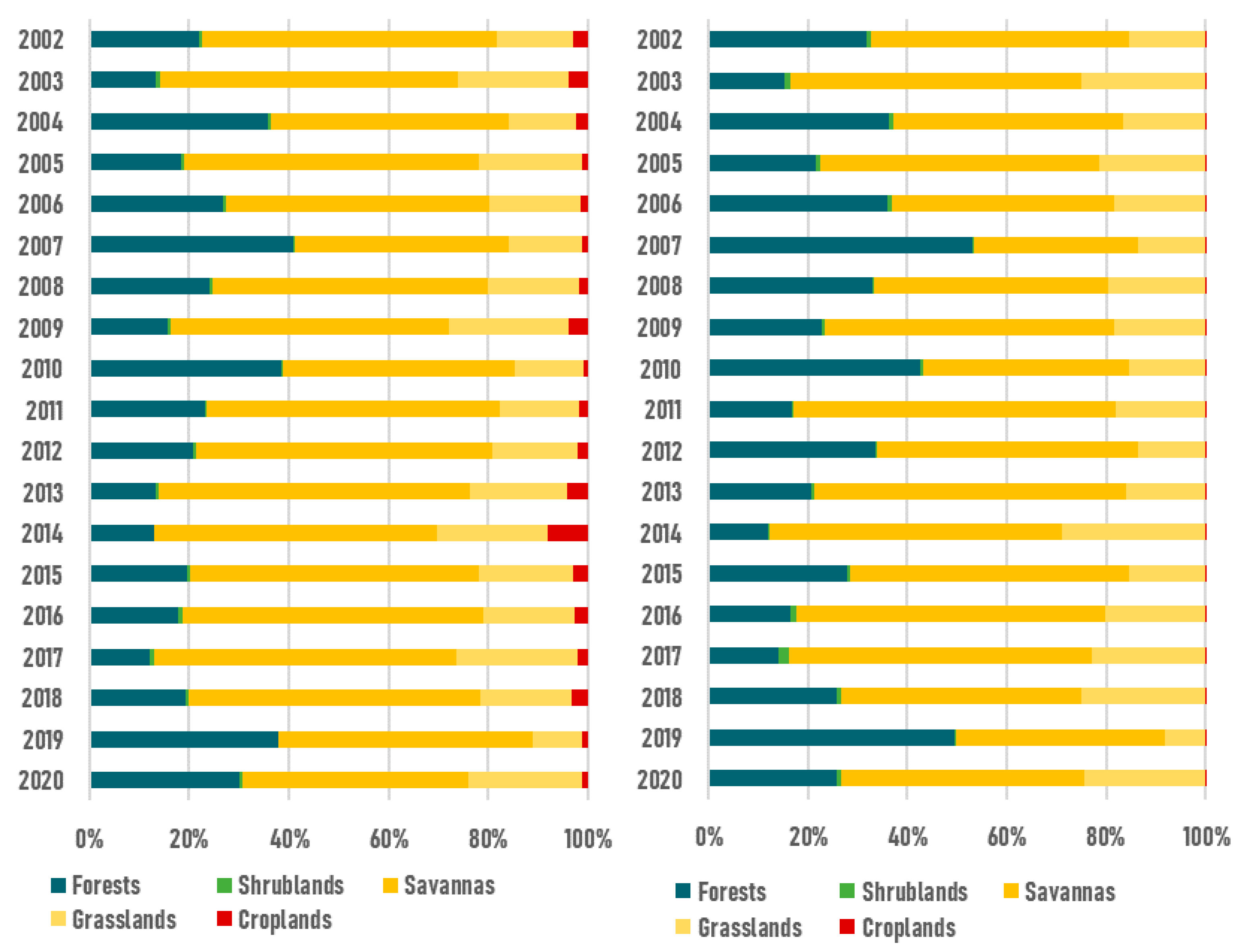

| KBA Code | KBA Name | Richness | Threatened | Endemic |
|---|---|---|---|---|
| 1 | Apolo | 326 | 9 | 1 |
| 2 | Área Natural de Manejo Integrado San Matías | 319 | 3 | - |
| 3 | Bajo Río Beni, Región Tacana | 426 | 9 | 1 |
| 4 | Bosque de Polylepis de Madidi | 262 | 9 | - |
| 5 | Lagunas de Agua Dulce de Potosí | 65 | 2 | - |
| 6 | Lagunas Salinas de Potosí | 73 | 2 | - |
| 7 | Cuenca Cotacajes | 193 | 3 | 5 |
| 8 | Cuencas de los Ríos Caine y Mizque | 184 | 3 | 5 |
| 9 | Bosque de Polylepis de Sanja Pampa | 71 | 2 | 3 |
| 10 | Bosque de Polylepis de Mina Elba | 77 | 3 | 2 |
| 11 | Bosque de Polylepis de Taquesi | 91 | 4 | 3 |
| 12 | Yungas Inferiores de Carrasco | 355 | 9 | 4 |
| 13 | Yungas Inferiores de Amboró | 359 | 8 | 2 |
| 14 | Yungas Superiores de Mosetenes y Cocapata | 394 | 9 | 4 |
| 15 | Yungas Superiores de Apolobamba | 344 | 11 | 1 |
| 16 | Yungas Superiores de Madidi | 415 | 10 | 1 |
| 17 | Lago Poopó y Río Laka Jahuira | 87 | 2 | - |
| 18 | Lago Titicaca (Sector Boliviano) | 95 | 2 | - |
| 19 | Parque Nacional Sajama | 84 | 3 | - |
| 20 | Noel Kempff Mercado | 429 | 12 | - |
| 21 | Reserva Biológica Cordillera de Sama | 132 | 4 | - |
| 22 | Cercanías de Riberalta | 420 | 7 | 1 |
| 23 | Vertiente Sur del Parque Nacional Tunari | 145 | 3 | 4 |
| 24 | Alto Paraguá | 318 | 4 | - |
| 25 | Cristal Mayu y alrededores | 331 | 9 | 4 |
| 26 | Azurduy | 218 | 4 | 1 |
| 27 | Cerrado de Riberalta | 403 | 6 | - |
| 28 | Cerro Q’ueñwa Sandora | 132 | 3 | 3 |
| 29 | Federico Román | 463 | 6 | - |
| 30 | Yungas Inferiores de Madidi | 465 | 11 | - |
| 31 | Yungas Inferiores de Isiboro-Sécure | 418 | 10 | 2 |
| 32 | Yungas Superiores de Amboró | 308 | 8 | 5 |
| 33 | Yungas Superiores de Carrasco | 308 | 7 | 5 |
| 34 | Palmar de las Islas | 269 | 1 | - |
| 35 | KAA-Iya del Gran Chaco | 282 | 2 | - |
| 36 | Laguna Rogaguado y Ginebra | 336 | 6 | - |
| 37 | Loreto | 333 | 7 | - |
| 38 | Estación Biológica del Beni | 378 | 5 | - |
| 39 | Quebrada Mojón | 133 | 3 | - |
| 40 | Reserva de Inmobilización de Iténez | 349 | 10 | - |
| 41 | Reserva Nacional Amazónica Manuripi | 464 | 7 | - |
| 42 | Reserva Nacional de Flora y Fauna Tariquia | 240 | 4 | - |
| 43 | Tacacoma-Quiabaya y Valle Sorata | 193 | 4 | 2 |
| 44 | Tahuamanu | 474 | 7 | 1 |
| 45 | Yungas Inferiores de Pilón Lajas | 450 | 9 | 3 |
| 46 | Serranía de Aguaragüe | 248 | 4 | 3 |
| 47 | Serranía Bella Vista | 303 | 7 | 1 |
| 48 | Área Natural de Manejo Integrado Otuquis | 297 | 2 | - |
| 49 | Oeste del río Mamoré | 333 | 8 | 2 |
| 50 | Este del río Mamoré | 333 | 8 | 2 |
| 51 | Cotapata | 301 | 9 | 4 |
| 52 | Comarapa | 209 | 3 | 3 |
| 53 | Río Huayllamarca | 80 | - | - |
| 54 | Culpina | 108 | 3 | - |
| 55 | Río Guadalquivir | 148 | 3 | - |
| 56 | Pampa Redonda | 213 | 4 | 2 |
| 57 | Prepuna del área del río San Juan | 113 | 2 | - |
| 58 | Cochabamba | 114 | 1 | 2 |
| Year | Moran’s Index | z-Score | p-Value | Distance Threshold (km) |
|---|---|---|---|---|
| 2001 | 0.0056 | 2.6243 | 0.0087 * | 113.4 |
| 2002 | 0.0033 | 5.4408 | 0.0000 * | 188.1 |
| 2003 | 0.0163 | 10.3768 | 0.0000 * | 70.3 |
| 2004 | 0.0028 | 2.6478 | 0.0081 * | 90.4 |
| 2005 | 0.0039 | 2.9402 | 0.0033 * | 91.0 |
| 2006 | 0.0045 | 5.6274 | 0.0000 * | 247.9 |
| 2007 | 0.0039 | 3.2603 | 0.0011 * | 125.9 |
| 2008 | 0.0120 | 7.3701 | 0.0000 * | 114.1 |
| 2009 | 0.0070 | 5.2465 | 0.0000 * | 101.6 |
| 2010 | 0.0034 | 2.4988 | 0.0125 * | 86.2 |
| 2011 | 0.0042 | 1.6745 | 0.0940 | 67.5 |
| 2012 | 0.0069 | 2.6792 | 0.0074 * | 87.0 |
| 2013 | 0.0083 | 3.7917 | 0.0002 * | 128.2 |
| 2014 | 0.0237 | 13.2323 | 0.0000 * | 150.9 |
| 2015 | 0.0122 | 6.6271 | 0.0000 * | 150.5 |
| 2016 | 0.0062 | 7.7785 | 0.0000 * | 311.1 |
| 2017 | 0.0109 | 6.7389 | 0.0000 * | 165.3 |
| 2018 | 0.0142 | 7.8238 | 0.0000 * | 128.7 |
| 2019 | 0.0015 | 1.2075 | 0.2272 | 150.5 |
| 2020 | 0.0156 | 5.7412 | 0.0000 * | 86.0 |
Publisher’s Note: MDPI stays neutral with regard to jurisdictional claims in published maps and institutional affiliations. |
© 2022 by the authors. Licensee MDPI, Basel, Switzerland. This article is an open access article distributed under the terms and conditions of the Creative Commons Attribution (CC BY) license (https://creativecommons.org/licenses/by/4.0/).
Share and Cite
Maillard, O.; Herzog, S.K.; Soria-Auza, R.W.; Vides-Almonacid, R. Impact of Fires on Key Biodiversity Areas (KBAs) and Priority Bird Species for Conservation in Bolivia. Fire 2022, 5, 4. https://doi.org/10.3390/fire5010004
Maillard O, Herzog SK, Soria-Auza RW, Vides-Almonacid R. Impact of Fires on Key Biodiversity Areas (KBAs) and Priority Bird Species for Conservation in Bolivia. Fire. 2022; 5(1):4. https://doi.org/10.3390/fire5010004
Chicago/Turabian StyleMaillard, Oswaldo, Sebastian K. Herzog, Rodrigo W. Soria-Auza, and Roberto Vides-Almonacid. 2022. "Impact of Fires on Key Biodiversity Areas (KBAs) and Priority Bird Species for Conservation in Bolivia" Fire 5, no. 1: 4. https://doi.org/10.3390/fire5010004
APA StyleMaillard, O., Herzog, S. K., Soria-Auza, R. W., & Vides-Almonacid, R. (2022). Impact of Fires on Key Biodiversity Areas (KBAs) and Priority Bird Species for Conservation in Bolivia. Fire, 5(1), 4. https://doi.org/10.3390/fire5010004







